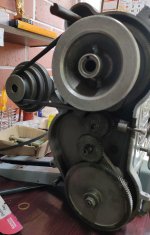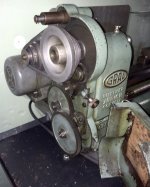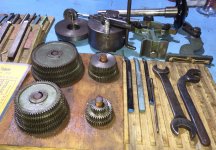I am not overly concerned about the pitch of the lead screw. If US lathe makers could make metric lead screws, then Swiss makers could certainly make English system (inch) ones.
What concerns me with this is the lack of a "banjo" arm where additional gears could be mounted. Are you sure that this lathe does not have provision for that?
Generally speaking sets of gears for cutting English system (TPI) threads are created in sizes that progress by fours or by fives. That means that they start with a small size gear, like 15 tooth and then progress with additional gears with tooth counts that are at five tooth intervals: 15, 20, 25, 30, 35, 40, 45, 50, 55, 60, 65, etc. This type of sequence provides all the prime numbers up to the one represented by the largest tooth count gear in the series. In my example the 65 tooth gear provides the prime number 13 because 5 x 13 = 65.
Why are prime numbers important? When you want to cut a thread that is measured in TPI (threads per inch) then your gear train/lead screw combination MUST have all of the prime numbers in it that are in in the pitch you want to cut. And in some cases you also need additional prime numbers that are in the lead screw that are NOT in the pitch you want to cut. For instance if you have an 8 TPI lead screw and want to cut a 32 TPI thread, then you have three 2s in the lead screw but 32's prime factors are five 2s so you need an additional two 2s in the gear train. Another example might be a 10 TPI lead screw and you need to cut a 36 TPI thread. 10 = 2 x 5 and 36 = 2 x 2 x 3 x 3. Your gears will need to contain the prime factors of 2, 3, 3, and 5. The 2 is for the second 2 that is not in the lead screw. The two 3s also are not in the lead screw and the 5 is in the lead screw but is not needed so it must be subtracted out in the gears.
If your lathe only allows the two gears, stud and lead screw, with only a single idler between them, then all your prime factors will have to be in the two gears mounted on those two shafts. And I fear that you should do the calculations or get a chart BEFORE you spend a lot of money having a sequence of gears made, only to find that one or many of the tooth counts you need are not in that sequence.
You say you have an 8 TPI lead screw, which is a popular size. DO CONFIRM THIS as best as you can. Then that 8 TPI lead screw has prime factors of 2 x 2 x 2. That's your starting point.
By the way, in order to cut the same TPI as the lead screw, you will need to have TWO gears with the SAME tooth count. My lathe has an 8 TPI lead screw and I have two 32 tooth gears that are used for cutting an 8 TPI thread. If you do not have an arm where compound gears can be mounted, there is no other way around this.
The general formula for the gearing on your lathe with an 8 TPI lead screw will be:
TPItoCut = 8 TPI x (ScrewGear# / StudGear#)
From that you can calculate the gears needed for each of the TPIs you wish to cut. You can also use a chart from another lathe that uses an 8 TPI lead screw. But you seem to be in favor of a sequence by fives. My lathe, with an 8 TPI lead screw, uses a sequence by fours, which probably saves money as smaller gears are needed to include the same number of primes. So, if you stick to the sequence by fives, you can only copy a table from another lathe that uses that sequence and they are probably somewhat rare.
If you want to switch to a sequence by fours, I can send you a chart.
PS: As you probably know, the idler gear can be any tooth count that spans the distance between the two gears you choose to use. It does not have any effect on the equation above.





